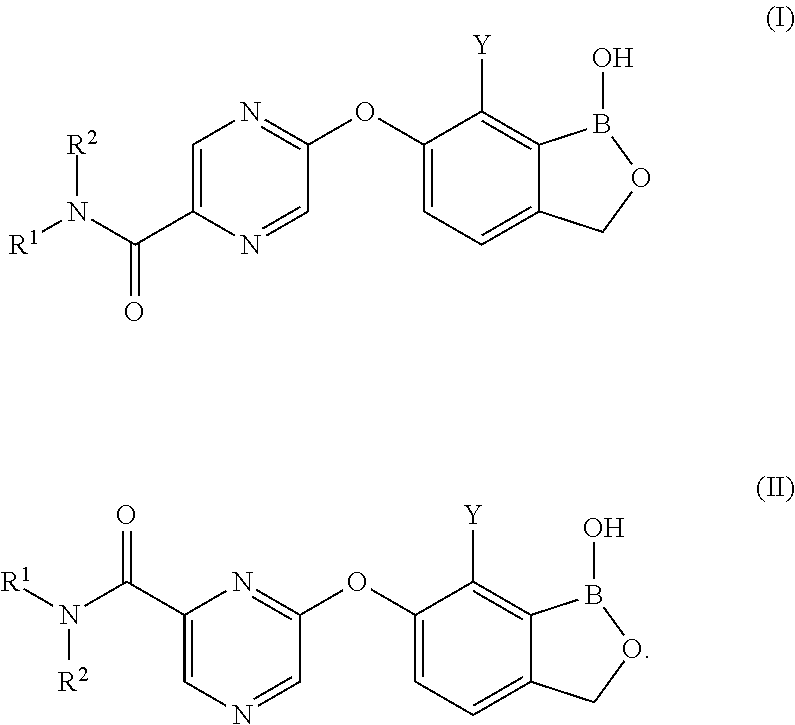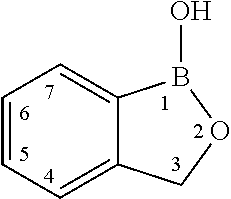Boron-containing small molecules as antiprotozoal1 agents
a technology of protozoal and small molecules, which is applied in the direction of antiparasitic agents, drug compositions, group 3/13 element organic compounds, etc., can solve the problems of global rise of protozoa resistant to antimicrobials in general, and pose a major threa
- Summary
- Abstract
- Description
- Claims
- Application Information
AI Technical Summary
Benefits of technology
Problems solved by technology
Method used
Image
Examples
example 1
5-((1-hydroxy-7-methyl-1,3-dihydrobenzo[c][1,2]oxaborol-6-yl)oxy)-N-(2-hydroxyethyl)pyrazine-2-carboxamide
[0303]
Step 1: Preparation of 5-chloro-N-(2-hydroxyethyl)pyrazine-2-carboxamide
[0304]To a solution of 5-chloropyrazine-2-carboxylic acid (600 mg, 4 mmol, 1 eq), 2-aminoethanol (300 mg, 4.8 mmol, 1.2 eq), HOBT (700 mg, 5.2 mmol, 1.3 eq) and EDC (1 g, 5.2 mmol, 1.3 eq) in DCM (25 mL, c=0.16) was added TEA (1.2 g, 12 mmol, 3 eq). The reaction was stirred at room temperature for 30 min. The mixture was washed with 1N HCl, saturated NaHCO3, brine, dried over MgSO4, filtered and evaporated to give the desired product (610 mg, 80% yield) as yellow oil.
Step 2: Preparation of 3-(benzyloxy)-6-formyl-2-methylphenyl trifluoromethanesulfonate
[0305]4-(benzyloxy)-2-hydroxy-3-methylbenzaldehyde (180 g, 742.97 mmol, 1.0 eq) in DCM (2000 mL) was charged into a 3-L 3-necked flask and pyridine (176.31 g, 2.23 mol, 3.0 eq) was then added. Trifluoromethanesulfonic anhydride (314.43 g, 1.114 mol, 1.5 e...
example 3
N-(1-hydroxy-2-methylpropan-2-yl)-5-(1-hydroxy-7-methyl-1,3-dihydrobenzo[c][1,2]oxaborol-6-yloxy)pyrazine-2-carboxamide
[0313]
Step 1: Preparation of 5-chloro-N-(1-hydroxy-2-methylpropan-2-yl)pyrazine-2-carboxamide
[0314]To a solution of 5-chloropyrazine-2-carboxylic acid (1 g, 6.33 mmol, 1 eq), HOBT (1.11 g, 8.23 mmol, 1.3 eq), and EDC-HCl (1.58 g, 8.23 mmol, 1.3 eq) in DCM (48 mL, c=0.13) were added TEA (1.9 g, 19.0 mmol, 3 eq) and 2-amino-2-methylpropan-1-ol (676 mg, 7.60 mmol, 1.2 eq). The solution was stirred for 2 h. After completion, the reaction was poured into 1N HCl (60 mL) and extracted with DCM (1×20 mL). The combined organic phases were washed with brine, dried over MgSO4, filtered and concentrated in vacuum. The residue was purified by column chromatography to give the 5-chloro-N-(1-hydroxy-2-methylpropan-2-yl)pyrazine-2-carboxamide (200 mg, 14% yield).
Step 2: Preparation of N-(1-hydroxy-2-methylpropan-2-yl)-5-(1-hydroxy-7-methyl-1, 3-dihydrobenzo[c][1,2]oxaborol-6-yloxy)...
example 4
N-(2-hydroxy-2-methylpropyl)-5-(1-hydroxy-7-methyl-1,3-dihydrobenzo[c][1,2]oxaborol-6-yloxy)pyrazine-2-carboxamide
[0316]
Step 1: Preparation of 5-chloro-N-(2-hydroxy-2-methylpropyl)pyrazine-2-carboxamide
[0317]To a solution of 5-chloropyrazine-2-carboxylic acid (1 g, 6.33 mmol, 1 eq), HOBT (1.1 g, 8.23 mmol, 1.3 eq), and EDC-HCl (1.58 g, 8.23 mmol, 1.3 eq) in DCM (48 mL) were added TEA (1.9 g, 19.0 mmol, 3 eq) and 1-amino-2-methylpropan-2-ol (676 mg, 7.60 mmol, 1.2 eq). The solution was stirred for 4 h. After completion, the reaction was poured into 1N HCl (10 mL) and extracted with DCM (1×10 mL). The organic phase was dried over MgSO4, filtered and concentrated in vacuum. The residue was purified by column chromatography to give the 5-chloro-N-(2-hydroxy-2-methylpropyl)pyrazine-2-carboxamide (1. g, 75% yield).
Step 2: Preparation of N-(2-hydroxy-2-methylpropyl)-5-(1-hydroxy-7-methyl-1,3-dihydrobenzo[c][1,2]oxaborol-6-yloxy)pyrazine-2-carboxamide
[0318]To a solution of 5-chloro-N-(2-hyd...
PUM
 Login to View More
Login to View More Abstract
Description
Claims
Application Information
 Login to View More
Login to View More - R&D
- Intellectual Property
- Life Sciences
- Materials
- Tech Scout
- Unparalleled Data Quality
- Higher Quality Content
- 60% Fewer Hallucinations
Browse by: Latest US Patents, China's latest patents, Technical Efficacy Thesaurus, Application Domain, Technology Topic, Popular Technical Reports.
© 2025 PatSnap. All rights reserved.Legal|Privacy policy|Modern Slavery Act Transparency Statement|Sitemap|About US| Contact US: help@patsnap.com



